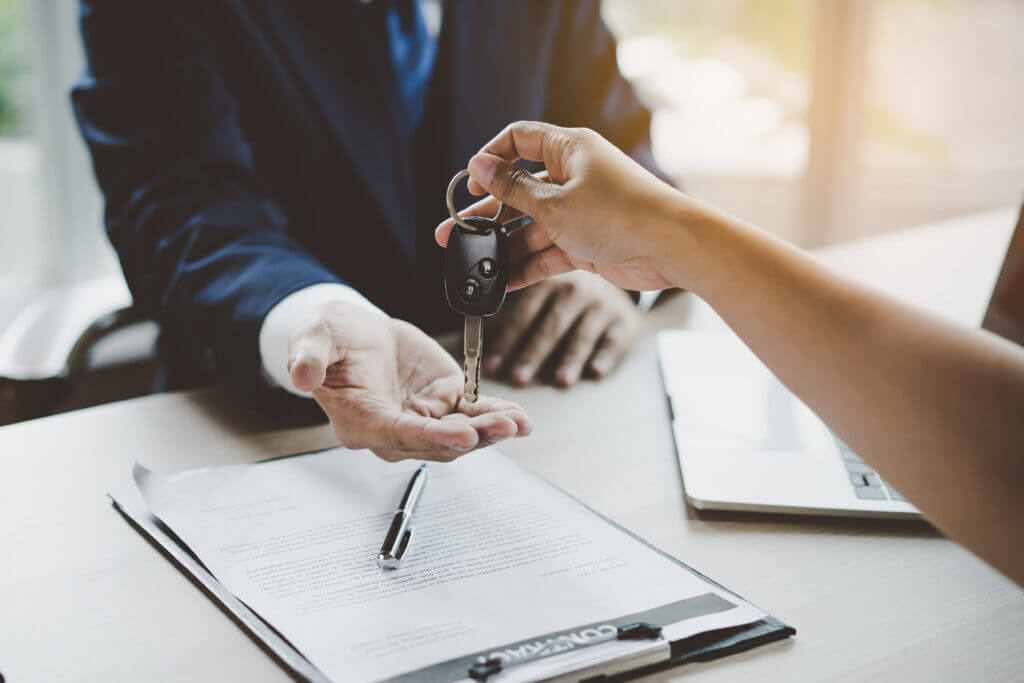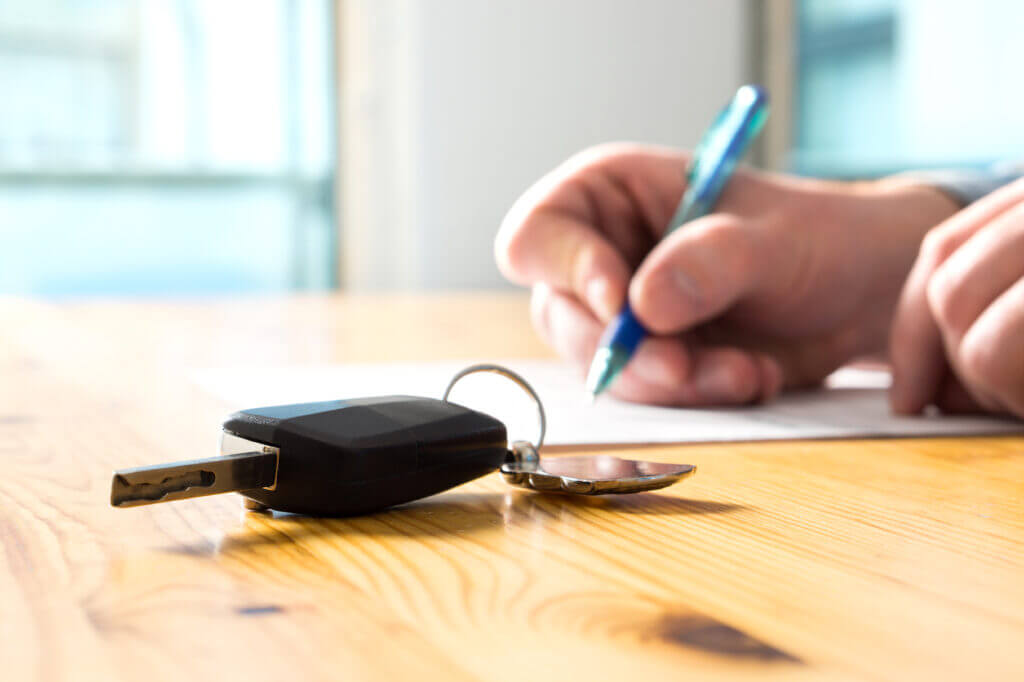At a glance
- If you’re buying a used car it’s really important that you transfer the ownership, otherwise you could face a fine
- It’s really easy to change your car ownership, you can do it online or at the post office – let us take you through the process
- Learn all about the role of the vehicle’s V5C and what needs to be done during a vehicle change of ownership
- Understand the differences between the owner of a car and the keeper, and who’s responsible for insuring it and paying tax
Are you thinking of selling a used car? Then you need to know how to legally change car ownership. The good news is that it’s actually fairly easy, and we’re here to help.
Transferring ownership of your car to its new keeper is a key step when you’re selling a car. You’ll need to follow an official process so that everything is registered by UK law, even if no money is changing hands.
The DVLA (which is the government’s Driver and Vehicle Licensing Agency) needs to be kept informed about a vehicle’s change of ownership. In this guide, we’ll walk you through the process. It’s not difficult, we promise!
Table of contents
- Why do you need to tell the DVLA about vehicle change of ownership?
- Everything you need to change car ownership
- Who can transfer car ownership?
- What is the difference between the owner and the keeper of a car?
- Who needs to complete the V5C?
- What to do on the car’s V5C?
- How to change car ownership online
- Transferring car ownership by post
- How to transfer the ownership of a car to a dealer or a scrapyard
- How to transfer car ownership to a family member
- Can you transfer your car’s tax?
- Fines for failing to notify the DVLA of a car transfer
- FAQs for changing car ownership
Why do you need to tell the DVLA about vehicle change of ownership?
The DVLA keeps a record of who owns every car in the country. They hold this information for various reasons, such as finding out who’s responsible for a car’s tax and MOT. But perhaps the most important reason is so the police can find out who owns a vehicle if it is stolen, or if the vehicle is caught speeding on a roadside camera.
This is why it’s a legal requirement to notify the DVLA about the new owner of a car. Failing to do so could result in a fine of £55 (or £35 if paid early) – and if you don’t pay that on time, it could result in an even bigger fine up to £1,000.
Another reason for telling the DVLA you’ve changed car ownership is that they’ll refund you any car tax remaining on the car – quids in!
Everything you need to change car ownership
No one likes doing paperwork, it can be quite a faff, we know. But, the good news is that transferring car ownership is actually quite straightforward once you’ve got the right documents and know where to go.
In short, to change car ownership you will need:
This is a vital piece of paperwork that you’ll need to sell your car. It has all the important information about the vehicle that is held by the DVLA on its database, and it proves that you are the registered keeper.
If you’re selling your car, you’ll need to complete the ‘new keeper’ section of V5C – also called V5C/2 – and give that to the new owner (we’ve explained how to do this below). It’s proof that they now own the vehicle.
If you don’t know where your V5C logbook is, or you’ve lost it, don’t panic! Scroll down to the FAQs at the bottom of this article to find out how to get a replacement.
- An internet connection
Many people now choose to record a vehicle change of ownership using the DVLA website. It’s a quick and simple way to change the logbook online. The DVLA will send you an email confirmation and then a follow-up letter in the post to indicate that the changes have been made. The new owner of the car will then receive a new V5C certificate through their letterbox.
- A Post Office
If you’d rather transfer ownership of your car by post you’ll still need the V5C document. Fill in the V5C section for ‘new keeper’, give the ‘new keeper’ slip to the new owner and post the remainder of the V5C to the DVLA (Swansea, SA99 IBA).

When do you need to transfer car ownership?
You have to tell the DVLA as soon as you hand over ownership of a car to its new keeper. You can change the logbook online, do it by post, or by visiting a Post Office.
You have to tell the DVLA about a vehicle change of ownership in other situations too:
- If you change address
- If you change your name
- After the owner dies
- If you’re giving the car away (e.g. to a family member)
- If you sell the car to a dealership
- If you sell the car at an auction
Who can transfer ownership of a car?
Only a vehicle’s registered keeper can legally transfer a car and its logbook into another name.
What is the difference between the owner and the keeper of a car?
Although the car’s owner and its keeper are usually one and the same person, they can also be different people or companies.
The owner is the person or company that paid for that car and legally owns it. If you drive a company car, then the company is usually the owner and you’re the keeper. Or if the car is a family car, the owner may be one of your parents while you could be the keeper (even if your parents don’t drive the vehicle).
The keeper of a vehicle is the person named on the V5C, also called the ‘registration document’ or ‘logbook’. The keeper is legally responsible for the car and is the person that would be pursued for any offences relating to the vehicle.
Even if someone else paid for the car, the legal keeper is the person in charge of insuring and paying tax on the vehicle, keeping it roadworthy and obtaining an MOT if it’s more than three years old. As the legal keeper, if your car is involved in any motoring offence, you’ll be the one contacted by the authorities and responsible for any fines.
Transferring ownership of a car after the keeper has passed away
If the car’s keeper has died, then their next of kin or a lawyer needs to notify the DVLA. They will need to write a letter listing their relationship to the deceased, when they died and who any tax refund should go to. They then post this letter along with the V5C to: DVLA Sensitive Casework Team, Swansea, SA99 1ZZ.
How to find out if you are the owner or the keeper of a car
If you bought a car outright for your own use, then you’ll usually be both the keeper and the owner.
If you have a V5C (vehicle logbook) for the car you drive and it has your name on it, this means you are its registered keeper. If you can’t find the logbook, then you can contact the DVLA to find out who the registered keeper is.
If you lease a car through a finance company, then they are usually the registered keeper and owner (check the paperwork you signed at the start of the lease).
If your car is a company car, then your company is normally the owner, and you are the keeper.
A final thing to note is that you might want to double-check that the person selling you a car is the actual owner. This can be done using various services online, and ensures you don’t end up buying a stolen car. Check out our piece on car registration checks to learn how to do this.

Who needs to complete the V5C?
Now the all-important bit. Let’s start looking at the practicalities of how to change car ownership.
The person who is the current keeper of the car being sold is responsible for completing the V5C and sending it to the DVLA to register the vehicle’s change of ownership. However, it’s important that the buyer – the new keeper – checks that all the information is correct and walks away with the ‘new keeper slip’. That little bit of paper is proof that they are the new owner of the car.
Completing the V5C is a really important step when you are changing the ownership of a car.
That is particularly true for the seller because by filling the logbook in with the new owner’s details and notifying the DVLA you’ll no longer be held responsible for a car you don’t own anymore (and you’ll automatically be refunded any road tax you’ve overpaid).
If you are the new keeper of the vehicle, you just have to wait for the old keeper to complete the transfer. If they change the logbook online, you should get a new V5C sent to your inbox naming you as the new legal keeper of the car within five working days. Bear in mind it can take longer if the previous keeper does the process by post.
How to complete a V5C
If you’re selling a used car, have a pen handy, because you’ll need it to transfer car ownership on the logbook. This legal document names the keeper and must be completed and sent back to the DVLA every time a vehicle changes hands. Then, a new one is issued in the new owner’s name.
From 15 April 2019, the V5C registration certificate was changed. Regardless of which version of the logbook you have, you should always fill it out in block capitals with a black ballpoint pen.
V5C issued after 15 April 2019:
- Seller – Complete section two, ‘selling or transferring my vehicle to a new keeper’
- Seller – Fill in the date of sale in section six ‘new keeper slip’. Tear it off and give it to the buyer
V5C issued before 15 April 2019
- Seller – Complete section six, called ‘new keeper details’
- Both – Sign the declaration in section eight.
- Seller – Fill in section 10, called V5C/2. Give the ‘new keeper supplement’ to the buyer.
How does a V5C certificate of logbook work?
The V5C document is a piece of paperwork you should receive when you become the new keeper of a car. It contains the following information:
- Date the car was first registered
- Current registered keeper (usually, this is you)
- The previous registered keeper
- Details about the vehicle
The V5C certificate functions as a record of who the official keeper of a car is – the DVLA needs to be informed every time there��s a change.
Can you buy or sell a car without a V5C?
Yes, you can buy or sell a car without a V5C, although it’s generally recommended to get all your paperwork sorted before you try selling a car.
Still, if you have lost the logbook, you are allowed to sell the car. But, you will need to provide the buyer with extra information so they can register their ownership of the vehicle with the DVLA. Here’s how you change ownership of a car without a logbook.
Provide the buyer a bill of sale that includes the following information (so they can apply for a new V5C):
- Car make and model
- Registration
- VIN number
- The buyer’s full name and address
- Date of the sale
- Signature of both parties
- Price and payment info
How to change car ownership online
While you can still register a vehicle change of ownership by post, it’s an awful lot faster to change the logbook online. Transferring car ownership on the DVLA’s website is quick and convenient.
Here’s how to change car ownership online:
STEP 1 – Get the details for the new owner, and double check they are correct. Include the new owner’s email address, home address, and full name.
STEP 2 – Get the 11-digit reference number from the car’s V5C
STEP 3 – Go online and complete the official form on the DVLA website.
- Confirm that you’re not a motor trader
- Select the options to confirm you’ve sold or transferred your vehicle
- State whether the sale or transfer was to a private individual or a motor trader
- Enter the car’s registration number
- Confirm the vehicle details are correct
- Enter the full name, postcode and address of the new owner and the date of sale
- Enter your email address – and that of the new owner if you want
- Declare that all the details you have entered are correct.
- Hit the ‘Confirm’ button
STEP 4 – You’ll receive an email confirmation, as will the new owner if you’ve included their email in the form.
STEP 5 – A brand new physical V5C or logbook will be sent to the new owner within five working days.
Once this is done, tear up and dispose of the old V5C since you are no longer the legal keeper of the car you’ve sold.

Transferring car ownership by post
If you feel more comfortable registering a vehicle change of ownership by post, you can do so.
- Get your copy of the V5C
- Enter the new owner’s name and address in the correct boxes (they may be different depending on when your V5C was issued as we’ve explained above).
- Tear off the New Keeper slip, fill out the date of Sale/Transfer and hand the slip to the new owner.
- Post the remainder of the V5C to the ‘DVLA, Swansea, SA99 IBA’.
- A brand new physical logbook will be sent to the new keeper in a few weeks.
How to transfer the ownership of a car to a dealer or scrap yard
Here’s how to change car ownership if you’re selling the vehicle to a dealer or trader, or are selling your car for scrap.
You can change the logbook online on the DVLA website by selecting the relevant options. To do it by post, this is the process:
- Fill in section 9 (instead of section 6, the one you need when selling your car privately), separate it from the rest of the V5C registration document and send it to the DVLA.
- Give the remaining parts of the V5C to the trader/scrapyard.
- The dealer will notify the DVLA of the change of ownership and the seller should receive a notification within four weeks.
How to transfer car ownership to a family member
Transferring car ownership to a family member is no different to doing so with a private seller. You can do it online or by post following all the steps listed above. Even if you’re giving an old car to one of your children, you must still inform the DVLA of any change of car ownership or that there’s a new keeper.
Can you transfer your car’s tax?
No. Road tax cannot be transferred between owners of a car. The new rules that came into force in 2014 put an end to issuing tax discs and allowed car sellers to get a full refund on the sold car’s remaining tax when there’s a change in car ownership. For that reason, you’ll need to tax the new car you’ve just bought before driving away with it. It’s a legal requirement.
To tax the car you need to:
- Find the green ‘new keeper’ slip from your new car’s log book, then either:
- Go to the official Car Tax page online, or;
- Call the DVLA over the phone (Mon-Fri 8am-7pm, Sat 8am-2pm), or;
- Find a Post Office that deals with vehicle tax
- Pay for it
Fines for failing to notify the DVLA of a car transfer
When you change car ownership, you must record this change with the DVLA. As the previous owner, you’re legally required to do this. If you don’t, you’re very likely to receive a penalty. You’ll receive an Out of Court Settlement letter demanding that you pay the DVLA £55 – reduced to £35 if you pay it in 17 days. Don’t ignore the letter, as you could end up in a magistrate’s court with a fine of up to £1,000.


